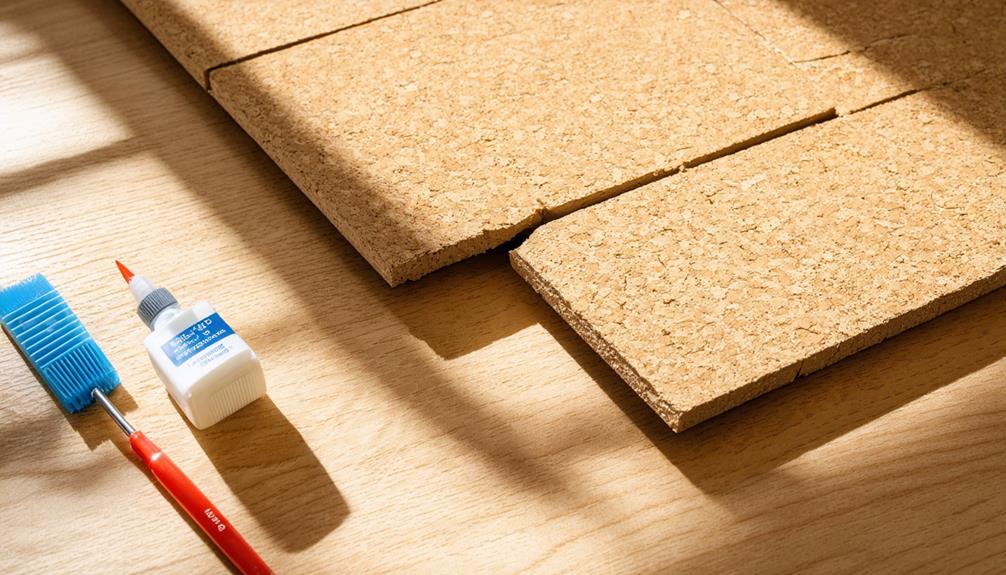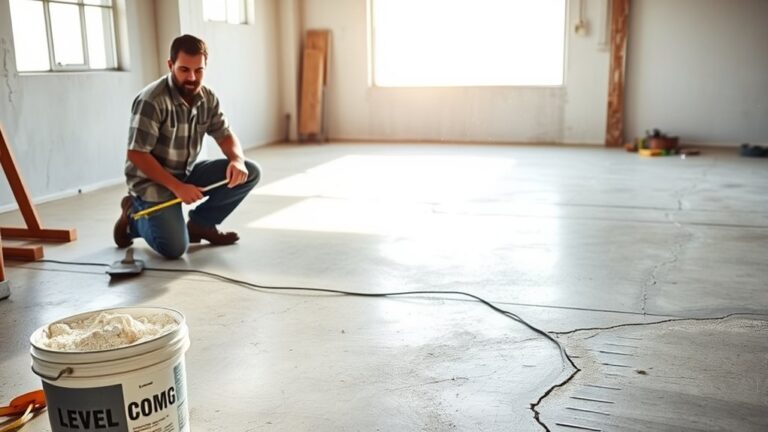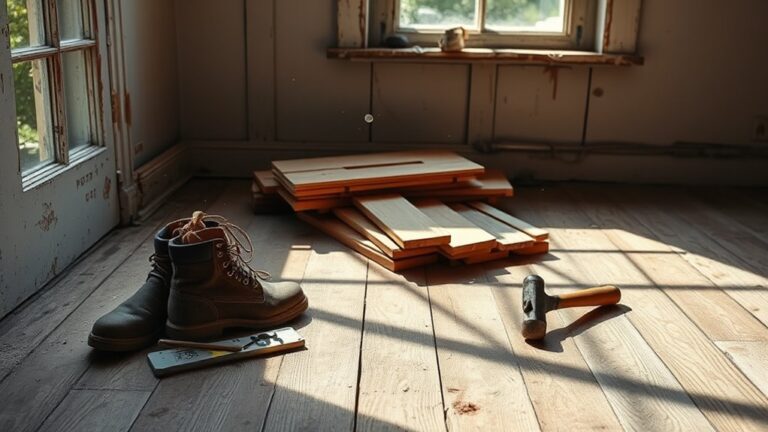Cork flooring can indeed face several issues, but knowing how to tackle them makes a difference. It's soft, which means you should use protective pads under furniture to prevent indentations. Moisture sensitivity is another challenge; make sure you've got proper moisture barriers and sealants in place. Fading from sunlight can be minimized with window treatments and UV coatings. Regular cleaning is essential, along with timely repairs to scratches to maintain its beauty. Attention to installation practices, including expansion gaps, is vital. For a deeper understanding of maintenance and preventive measures, further insights await.
Susceptibility to Damage
When it comes to cork flooring, susceptibility to damage is a significant concern that homeowners should be aware of. While cork offers a unique aesthetic and comfort, it's important to recognize that its softness makes it prone to indentations, especially from heavy furniture and high heels. To protect against this, you should always use protective pads under furniture legs. This simple step can minimize unsightly marks and prolong the life of your cork flooring.
Additionally, frequent movement of heavy items can lead to scratches and permanent damage. If you anticipate rearranging furniture often, consider choosing a more durable flooring option or limit the movement of heavy objects on cork. It's also essential to avoid placing cork in high foot traffic areas where wear can accumulate quickly.
Regular maintenance is key to preserving the appearance of your cork flooring. This includes routine cleaning, as well as periodic sanding and refinishing to address any scratches that may arise over time. Without this maintenance, you might find the lifespan of your cork flooring shortened compared to traditional hardwoods.
Moisture Sensitivity
Cork flooring's moisture sensitivity can lead to significant issues if not addressed properly. You'll want to focus on installing effective moisture barriers, recognizing signs of excess moisture, and maintaining your flooring for ideal resistance. By taking these steps, you can prevent extensive damage and guarantee the longevity of your cork floors.
Importance of Moisture Barriers
Understanding the importance of moisture barriers is essential for maintaining the integrity of cork flooring. Prolonged exposure to moisture can lead to saturation, warping, and mold growth, which compromise your flooring's durability and aesthetics. In areas prone to spills or high humidity, installing moisture barriers becomes a non-negotiable step in your flooring project.
Cork flooring, particularly when constructed with High-Density Fibreboard (HDF), can react negatively to excessive moisture. This makes it vital to prevent any moisture intrusion that could lead to mechanical issues like buckling. Additionally, cork can expand by up to one inch in moisture-laden environments, underscoring the need for a robust moisture barrier.
Choosing the right flooring for specific areas, coupled with effective moisture barriers, is key to mitigating damage from high humidity and moisture exposure. Regularly sealing your cork surfaces enhances protection and prolongs the lifespan of your flooring. By prioritizing moisture barriers, you empower yourself to maintain the beauty and functionality of your cork flooring while ensuring it withstands the test of time.
Signs of Excess Moisture
As excess moisture infiltrates your cork flooring, you'll likely notice several telltale signs that demand your attention. Recognizing these indicators early can help you maintain the integrity of your flooring and prevent further damage.
| Signs of Excess Moisture | Implications |
|---|---|
| Warping or Cupping of Planks | Absorbed more water than it can handle |
| Gaps Between Planks | Expansion beyond limits |
| Mold Formation | Prolonged exposure to high humidity |
If you observe warping, cupping, or gaps, it's vital to act quickly. These signs indicate that moisture levels are higher than they should be, which can lead to serious issues. A moisture barrier, such as a vapor barrier, is essential, especially in moisture-prone areas. Regular inspections for these signs of excess moisture can help you address issues before they escalate. Additionally, promptly cleaning spills and monitoring humidity levels will greatly reduce the risk of mold formation. By staying vigilant, you'll prolong the life of your cork flooring and enjoy its natural beauty without the worry of moisture damage.
Maintenance for Moisture Resistance
To maintain the integrity of your cork flooring and enhance its moisture resistance, regular maintenance is vital. Start by sealing your cork flooring every few years. This step not only boosts moisture resistance but also protects against stains and water absorption. When installing cork flooring, consider adding moisture barriers underneath, especially in moisture-prone areas like kitchens and bathrooms. This can greatly prevent damage from spills and high humidity.
It's essential to promptly clean up spills and excess moisture. Cork's porous nature can lead to swelling and mold growth if any moisture is left unaddressed. To further safeguard your flooring, maintain consistent indoor humidity levels between 40-60%. This practice minimizes cork's natural expansion and contraction, reducing the risk of warping.
When cleaning, use pH-neutral cleaners specifically designed for cork. These will help maintain your flooring's integrity while protecting against moisture-related damage. By following this maintenance for moisture resistance, you can enjoy the benefits of durable flooring that remains beautiful and functional for years to come. Your proactive approach will guarantee your cork flooring stands up to the challenges of moisture, allowing for a worry-free environment.
Fading and Discoloration
Cork flooring can lose its vibrant color over time due to fading and discoloration caused by prolonged exposure to direct sunlight. The harmful UV rays from the sun can markedly reduce the vibrancy of your cork, leading to a less appealing aesthetic in your living space. To maintain the integrity of your flooring, it's crucial to implement protective measures.
First, consider using window treatments like blinds or curtains to block direct sunlight during peak hours. This simple step can dramatically reduce the amount of UV exposure your cork flooring receives. If you prefer a more permanent solution, applying UV-protective films to your windows can offer long-lasting protection against harmful rays.
Another effective strategy is to rotate your furniture and rugs periodically. By changing their positions, you can help distribute sunlight exposure evenly across your cork flooring. This practice prevents uneven fading and maintains a more uniform appearance.
Additionally, applying UV-resistant coatings to your cork flooring can enhance its durability against sunlight and minimize the risk of discoloration. These coatings create a barrier that protects the surface from UV damage, allowing you to enjoy your flooring's original color for years to come.
Cost Considerations
When considering cork flooring, it's important to understand the associated costs beyond just the initial purchase price. While cork can be an appealing choice due to its eco-friendliness, the financial implications require careful analysis.
Here are some cost considerations to keep in mind:
- Initial Costs: Cork flooring typically ranges from $3 to $9 per square foot, with professional installation adding another $2 to $4. This upfront investment can be higher than conventional flooring options.
- Maintenance Costs: To keep your cork flooring in good condition, you'll need to reseal it every 5 to 7 years. These ongoing maintenance costs can accumulate and may exceed your initial expectations.
- Environmental Impact: Although cork is marketed as a sustainable choice, consider the environmental impact of its production and transportation. These factors can contribute to the overall cost and may affect your commitment to eco-friendliness.
Additionally, the resale value of cork flooring may not rival that of traditional hardwoods. It's essential for you to weigh the environmental benefits against the financial investment. If you're passionate about sustainability but also concerned about long-term costs and property value, evaluating these factors will help guide your decision. By understanding the full scope of cork flooring costs, you can make a more informed choice that aligns with your values and lifestyle.
Installation Challenges
Installation challenges can greatly impact the performance and longevity of cork flooring. To guarantee that your cork flooring remains beautiful and functional, it's essential to use proper installation techniques. Improper installation, such as tight seams, can lead to issues like lipping and gapping, which could surface immediately or develop over time.
One common pitfall is neglecting the necessary expansion gaps of at least 1/2 inch at walls. These gaps accommodate the natural expansion of cork, preventing severe mechanical problems like buckling. If you're laying a floating floor, remember that it's particularly susceptible to separation if not installed correctly. Beveled edges can make these issues worse if tapping and alignment aren't maintained.
Moisture is another significant concern, especially in basements. Excess moisture can cause catastrophic effects, including buckling of planks, which may necessitate immediate action and potential removal of flooring. To combat this, always check for moisture levels before installation.
A clean, dry, and level subfloor is important for a successful cork flooring installation. Irregularities in the subfloor can lead to joint separation and increased wear over time. By addressing these installation challenges head-on, you'll not only enhance the performance of your cork flooring but also guarantee its longevity, giving you the freedom to enjoy your space without worry.
Maintenance Requirements
To keep your cork flooring looking its best and guarantee its longevity, regular maintenance is key. This involves a few essential tasks that, when done consistently, will protect your investment and enhance the natural beauty of your floors.
- Regular Cleaning: Use a soft broom or a vacuum with a brush attachment to prevent dirt buildup, which can lead to surface wear. Avoid abrasive tools that could scratch the finish.
- Reapply Protective Sealants: Every 5-7 years, you should apply protective sealants to maintain the integrity of your cork flooring. These sealants guard against stains, moisture, and everyday wear.
- Address Scratches Promptly: Because cork is susceptible to scratches from pets and heavy furniture, it's important to address any scratches as soon as you notice them. Buffing or refinishing can restore your floor's appearance and prevent further damage.
Additionally, regular cleaning is essential for preserving the hypoallergenic properties of cork flooring. This minimizes dust and allergens, which is especially important in homes with sensitive individuals. By adhering to these maintenance requirements, you'll not only keep your cork flooring looking pristine but also extend its life, ensuring that it remains a beautiful and functional part of your home for years to come.
Frequently Asked Questions
What Is One Downside of Cork Flooring?
One downside of cork flooring is its durability, especially in high-traffic areas. While cork installation offers aesthetic appeal, it's prone to scratches and indentations from heavy furniture or pet claws. To maintain its appearance, you'll need regular cork flooring maintenance, including resealing every 5-7 years. Additionally, without proper care, moisture can warp the material, compromising both durability and aesthetics. So, consider these factors when choosing cork flooring for your space.
What Is the Life Expectancy of Cork Flooring?
Isn't it fascinating how the right flooring can transform your space? When it comes to cork flooring, its life expectancy typically ranges from 10 to 30 years, largely influenced by cork flooring maintenance and installation quality. Regular resealing every 5 to 7 years enhances durability, while the aesthetic appeal and eco-friendliness of cork flooring benefits you in the long run. So, investing in higher-quality options can really pay off, ensuring lasting beauty and functionality.
What Happens if Cork Flooring Gets Wet?
If cork flooring gets wet, you risk water damage that can lead to warping and mold growth. To prevent moisture issues, guarantee you regularly maintain your flooring and seal it properly. If spills occur, use effective drying techniques quickly to avoid saturation. Regular maintenance tips include monitoring humidity levels and promptly addressing any leaks. By taking these actions, you can protect your cork flooring and extend its lifespan.
Will Mold Grow on Cork Flooring?
Mold on cork flooring can be a sneaky intruder! To keep it at bay, focus on mold prevention tips like regular sealing and immediate cleanup of spills. Cork flooring maintenance is key, so guarantee proper humidity control techniques are in place, especially in damp areas. Use mold detection methods to spot any issues early. With vigilance and care, you can enjoy your beautiful cork floors without the worry of unwanted mold growth.




